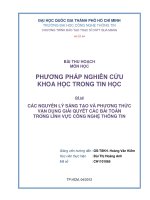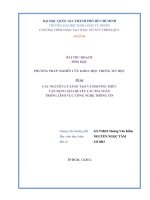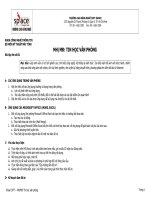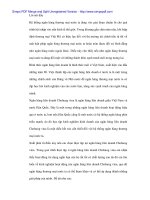BÀI TẬP LỚN MẬT MÃ VÀ AN TOÀN DỮ LIỆU VẤN ĐỀ TÍNH TOÁN VỚI CÁC SỐ LỚN
Bạn đang xem bản rút gọn của tài liệu. Xem và tải ngay bản đầy đủ của tài liệu tại đây (158.04 KB, 14 trang )
ĐẠI HỌC QUỐC GIA HÀ NỘI
TRƯỜNG ĐẠI HỌC CÔNG
NGHỆ
CỘNG HÒA XÃ HỘI CHỦ NGHĨA VIỆT NAM
Độc lập - Tự do - Hạnh phúc
BÀI TẬP LỚN
MÔN HỌC: MẬT MÃ VÀ AN TOÀN DỮ LIỆU
ĐỀ TÀI:
VẤN ĐỀ TÍNH TOÁN VỚI CÁC SỐ LỚN
Họ tên: Trần Thị Mùi.
Lớp: Cao học K20
Mã học viên: 13025086
Giảng viên hướng dẫn: PGS.TS. Trịnh Nhật Tiến
Hà nội, 2014
1
I. Giới thiệu
Vấn đề tính toán với các số lớn có ý nghĩa rất lớn trong thực tế. Chẳng hạn như thuật
toán mã hóa công khai RSA (do Rivers, Shamir và Adleman viết ra vào năm 1978 ) sử
dụng tới 512 số khóa (thuật toán này có liên quan tới việc phân tích các số nguyên tố).
Trong nhiều ngành khoa học kĩ thuật chúng ta phải sử dụng tới các con số lớn hơn thế
rất nhiều.
Một số vấn đề liên quan tới việc tính toán với các số lớn như: kiểm tra tính nguyên
tố của một số lớn , khai căn bậc hai của số lớn, vấn đề tính lũy thừa với số lớn theo
modulo, vấn đề tính phần tử nghịch đảo theo modulo, vấn đề tính giai thừa số lớn, vấn
đề các phép toán trên số lớn…
Đặt Vấn Đề:
Trong các ngôn ngữ lập trình cấp cao như Pascal, C, C#, … hỗ trợ kiểu dữ liệu số
nguyên và các phép toán trên số học. Nhưng, độ lớn của chữ số có giới hạn. Trong
Pascal, một số nguyên được lưu trữ tối đa là 32 bit (4 byte), trong C# là 64 bit (8 byte).
Do đó, để có thể thực hiện được các phép toán số học với các số lớn vượt ra khỏi giới
hạn kiểu dữ liệu số của ngôn ngữ lập trình, người lập trình cần xây dựng riêng cho
mình một cấu trúc dữ liệu có thể lưu được số lớn, và các phép toán số học trên cấu trúc
dữ liệu đó. Sau đây, em xin trình bày một phương pháp xây dựng số lớn và các phép
toán số học trên số lớn trên C#.
II. Bài toán
1. Phát biểu bài toán
Bài toán đặt ra: cho hai số nguyên lớn a và b có độ dài lần lượt là m và n (chứa m và
n chữ số). Thực hiện hai nhiệm vụ:
• Xử lý dữ liệu với hai số nguyên lớn a và b: vì hai số này vượt qua khỏi giới hạn
của các kiểu dữ liệu số mà máy hỗ trợ. Vì vậy ta phải thực hiện đưa nó về các
kiểu dữ liệu số mà máy có thể hỗ trợ để thực hiện cho việc tính toán.
• Thực hiện các phép toán với hai số: phép toán cộng, trừ, nhân, chia.
2
2. Thực hiện các bước của bài toán
2.1. Xử lý dữ liệu
- Đưa dữ liệu về các kiểu số nguyên đã có mà máy hỗ trợ sẵn để tạo ra kiểu số lớn.
- Tư tưởng: thực hiện biểu diễn thành các block, mỗi block gồm 4 byte
- Thực hiện: đưa các chữ số vào trong các block, được thực hiện bởi BigInteger(string
value, int radix), trong đó value là giá trị truyền vào, radix là hệ cơ số.
- Xác đinh bởi công thức:
result = result + (multiplier * posVal);
multiplier = multiplier *radix;
- Xử lý dữ liệu được xác định bởi thủ tục như sau:
public BigInteger(string value, int radix)
{
BigInteger multiplier = new BigInteger(1);
BigInteger result = new BigInteger();
value = (value.ToUpper()).Trim();
int limit = 0;
if(value[0] == '-')
limit = 1;
for(int i = value.Length - 1; i >= limit ; i )
{
int posVal = (int)value[i];
if(posVal >= '0' && posVal <= '9')
posVal -= '0';
else if(posVal >= 'A' && posVal <= 'Z')
posVal = (posVal - 'A') + 10;
else
posVal = 9999999; // arbitrary large
if(posVal >= radix)
throw(new ArithmeticException("Invalid string in constructor."));
else
{
if(value[0] == '-')
posVal = -posVal;
result = result + (multiplier * posVal);
3
if((i - 1) >= limit)
multiplier = multiplier * radix;
}
}
if(value[0] == '-') // negative values
{
if((result.data[maxLength-1] & 0x80000000) == 0)
throw(new ArithmeticException("Negative underflow in
constructor."));
}
else // positive values
{
if((result.data[maxLength-1] & 0x80000000) != 0)
throw(new ArithmeticException("Positive overflow in
constructor."));
}
data = new uint[maxLength];
for(int i = 0; i < result.dataLength; i++)
data[i] = result.data[i];
dataLength = result.dataLength;
}
Khi thực hiện xử lý dữ liệu theo kiểu như trên có một ưu điểm hơn so với trường
hợp ta đưa các chữ số về dạng String. Nếu theo dạng như String thì mỗi một chữ số sẽ
được lưu trong một block, còn trương hợp như trên, trong mỗi một block ta lưu được
nhiều chữ số, vì thế sẽ không gây ra trường hợp lãng phí bộ nhớ và thời gian thực hiện
nhanh hơn.
2.2. Thực hiện các phép toán
2.2.1. Phép toán cộng
- Thực hiện cộng trong mỗi một block, thực hiện công như phép tính cộng bình thường
- Sử dụng một biến carry để lưu trữ biến nhớ. Khi đó kết quả của phần tử thứ i sẽ là:
long sum = (long)bi1.data[i] + (long)bi2.data[i] + carry;
carry = sum >> 32;
result.data[i] = (uint)(sum & 0xFFFFFFFF);
- Trước khi ra kết quả trả về là một số lớn có giá trị bằng tổng của hai số, sau khi thực
hiện cộng tổng hai số ta thực hiện and nó trong hệ hexa và cuối cùng cho ra kết quả trả
về.
- Thủ tục như sau:
4
public static BigInteger operator +(BigInteger bi1, BigInteger bi2)
{
BigInteger result = new BigInteger();
result.dataLength = (bi1.dataLength > bi2.dataLength) ? bi1.dataLength :
bi2.dataLength;
long carry = 0;
for(int i = 0; i < result.dataLength; i++)
{
long sum = (long)bi1.data[i] + (long)bi2.data[i] + carry;
carry = sum >> 32;
result.data[i] = (uint)(sum & 0xFFFFFFFF);
}
if(carry != 0 && result.dataLength < maxLength)
{
result.data[result.dataLength] = (uint)(carry);
result.dataLength++;
}
while(result.dataLength > 1 && result.data[result.dataLength-1] == 0)
result.dataLength ;
// overflow check
int lastPos = maxLength - 1;
if((bi1.data[lastPos] & 0x80000000) == (bi2.data[lastPos] & 0x80000000)
&&
(result.data[lastPos] & 0x80000000) != (bi1.data[lastPos] & 0x80000000))
{
throw (new ArithmeticException());
}
return result;
2.2.2. Phép toán trừ
- Thực hiên trong mỗi một block và thực hiện trừ như phép trừ bình thường.
- Sử dụng một biến carry để lưu trữ biến nhớ:
+ Nếu kết quả nhỏ hơn không: carry=1
+ Ngược lại: carry=0.
- Kết quả của phần tử thứ i sẽ là:
long diff = (long)bi1.data[i] - (long)bi2.data[i] -carry;
5
result.data[i] = (uint)(diff & 0xFFFFFFFF);
- Thủ tuc thực hiện như sau:
public static BigInteger operator -(BigInteger bi1, BigInteger bi2)
{
BigInteger result = new BigInteger();
result.dataLength = (bi1.dataLength > bi2.dataLength) ? bi1.dataLength :
bi2.dataLength;
long carryIn = 0;
for(int i = 0; i < result.dataLength; i++)
{
long diff;
diff = (long)bi1.data[i] - (long)bi2.data[i] - carryIn;
result.data[i] = (uint)(diff & 0xFFFFFFFF);
if(diff < 0)
carryIn = 1;
else
carryIn = 0;
}
// roll over to negative
if(carryIn != 0)
{
for(int i = result.dataLength; i < maxLength; i++)
result.data[i] = 0xFFFFFFFF;
result.dataLength = maxLength;
}
// fixed in v1.03 to give correct datalength for a - (-b)
while(result.dataLength > 1 && result.data[result.dataLength-1] == 0)
result.dataLength ;
// overflow check
int lastPos = maxLength - 1;
if((bi1.data[lastPos] & 0x80000000) != (bi2.data[lastPos] & 0x80000000)
&&
(result.data[lastPos] & 0x80000000) != (bi1.data[lastPos] & 0x80000000))
{
6
throw (new ArithmeticException());
}
return result;
}
2.2.3. Phép nhân
- Nhân từng phần tử của số b với số a, kết quả thu được lưu vào trong mang data[k].
- Kết quả mỗi phần tử thứ i được xác định bởi công thức như sau:
ulong Val= bi1.data[i]*bi2.data[j]+ result.data[k]+mcarry;
rusult.data[k]= (unit)(Val&0xFFFFFFFF)
mcarry=(val>>32)
- Thủ tục thực hiện như sau:
public static BigInteger operator *(BigInteger bi1, BigInteger bi2)
{
int lastPos = maxLength-1;
bool bi1Neg = false, bi2Neg = false;
// take the absolute value of the inputs
try
{
if((bi1.data[lastPos] & 0x80000000) != 0) // bi1 negative
{
bi1Neg = true; bi1 = -bi1;
}
if((bi2.data[lastPos] & 0x80000000) != 0) // bi2 negative
{
bi2Neg = true; bi2 = -bi2;
}
}
catch(Exception) {}
BigInteger result = new BigInteger();
// multiply the absolute values
try
{
for(int i = 0; i < bi1.dataLength; i++)
{
if(bi1.data[i] == 0) continue;
7
ulong mcarry = 0;
for(int j = 0, k = i; j < bi2.dataLength; j++, k++)
{
// k = i + j
ulong val = ((ulong)bi1.data[i] * (ulong)bi2.data[j]) +
(ulong)result.data[k] + mcarry;
result.data[k] = (uint)(val & 0xFFFFFFFF);
mcarry = (val >> 32);
}
if(mcarry != 0)
result.data[i+bi2.dataLength] = (uint)mcarry;
}
}
catch(Exception)
{
throw(new ArithmeticException("Multiplication overflow."));
}
result.dataLength = bi1.dataLength + bi2.dataLength;
if(result.dataLength > maxLength)
result.dataLength = maxLength;
while(result.dataLength > 1 && result.data[result.dataLength-1] == 0)
result.dataLength ;
// overflow check (result is -ve)
if((result.data[lastPos] & 0x80000000) != 0)
{
if(bi1Neg != bi2Neg && result.data[lastPos] == 0x80000000) //
different sign
{
// handle the special case where multiplication produces
// a max negative number in 2's complement.
if(result.dataLength == 1)
return result;
else
{
bool isMaxNeg = true;
8
for(int i = 0; i < result.dataLength - 1 && isMaxNeg; i++)
{
if(result.data[i] != 0)
isMaxNeg = false;
}
if(isMaxNeg)
return result;
}
}
throw(new ArithmeticException("Multiplication overflow."));
}
// if input has different signs, then result is -ve
if(bi1Neg != bi2Neg)
return -result;
return result;
}
2.2.4. Phép chia
- Thực hiện với hai trường hợp:
+ Nếu b chỉ có 1 block: ta thực hiện chia như bình thường, kiểm tra độ dài của a, nếu
nếu a nhỏ hơn b thì ta cho ra kết quả thương= 0 và số dư sẽ là kết quả của a. Nếu a > b
ta thực hiện: ta xét từng phần nhỏ trong a
dividend = ((ulong)outRemainder.data[pos+1] << 32) +
(ulong)outRemainder.data[pos];
ulong quotient = dividend / divisor;
result[resultPos++] = (uint)quotient;
outRemainder.data[pos+1] = 0;
outRemainder.data[pos ] = (uint)(dividend % divisor);
Sau khi thực hiện chia xong lại kiểm tra tiếp giá trị của a là số outRemainder[] (biến
phần nhỏ của a), nếu nhỏ hơn ta tiến hành dịch bít a và thêm vào sau phần nhỏ của a
Ta có thủ tục:
private static void singleByteDivide(BigInteger bi1, BigInteger bi2,
BigInteger outQuotient, BigInteger outRemainder)
{
9
uint[] result = new uint[maxLength];
int resultPos = 0;
// copy dividend to reminder
for(int i = 0; i < maxLength; i++)
outRemainder.data[i] = bi1.data[i];
outRemainder.dataLength = bi1.dataLength;
while(outRemainder.dataLength > 1 &&
outRemainder.data[outRemainder.dataLength-1] == 0)
outRemainder.dataLength ;
ulong divisor = (ulong)bi2.data[0];
int pos = outRemainder.dataLength - 1;
ulong dividend = (ulong)outRemainder.data[pos];
//Console.WriteLine("divisor = " + divisor + " dividend = " + dividend);
//Console.WriteLine("divisor = " + bi2 + "\ndividend = " + bi1);
if(dividend >= divisor)
{
ulong quotient = dividend / divisor;
result[resultPos++] = (uint)quotient;
outRemainder.data[pos] = (uint)(dividend % divisor);
}
pos ;
while(pos >= 0)
{
//Console.WriteLine(pos);
dividend = ((ulong)outRemainder.data[pos+1] << 32) +
(ulong)outRemainder.data[pos];
ulong quotient = dividend / divisor;
result[resultPos++] = (uint)quotient;
outRemainder.data[pos+1] = 0;
outRemainder.data[pos ] = (uint)(dividend % divisor);
//Console.WriteLine(">>>> " + bi1);
}
outQuotient.dataLength = resultPos;
10
int j = 0;
for(int i = outQuotient.dataLength - 1; i >= 0; i , j++)
outQuotient.data[j] = result[i];
for(; j < maxLength; j++)
outQuotient.data[j] = 0;
while(outQuotient.dataLength > 1 &&
outQuotient.data[outQuotient.dataLength-1] == 0)
outQuotient.dataLength ;
if(outQuotient.dataLength == 0)
outQuotient.dataLength = 1;
while(outRemainder.dataLength > 1 &&
outRemainder.data[outRemainder.dataLength-1] == 0)
outRemainder.dataLength ;
}
+ Trường hợp b có nhiều hơn 1 block: ta xét từng phần nhỏ trong a, phần nhỏ nhận giá
trị và dừng lại khi lớn hơn b. Thực hiện trừ dần phần nhỏ đã xét với b, được bao nhiêu
lưu vào trong một biến tạm, sau khi thực hiện xong phép trừ ta được kết quả là thương
của phép chia.
Ta có thủ tục:
private static void multiByteDivide(BigInteger bi1, BigInteger bi2,
BigInteger outQuotient, BigInteger outRemainder)
{
uint[] result = new uint[maxLength];
int remainderLen = bi1.dataLength + 1;
uint[] remainder = new uint[remainderLen];
uint mask = 0x80000000;
uint val = bi2.data[bi2.dataLength - 1];
int shift = 0, resultPos = 0;
while(mask != 0 && (val & mask) == 0)
{
shift++; mask >>= 1;
}
//Console.WriteLine("shift = {0}", shift);
11
//Console.WriteLine("Before bi1 Len = {0}, bi2 Len = {1}", bi1.dataLength,
bi2.dataLength);
for(int i = 0; i < bi1.dataLength; i++)
remainder[i] = bi1.data[i];
shiftLeft(remainder, shift);
bi2 = bi2 << shift;
/*
Console.WriteLine("bi1 Len = {0}, bi2 Len = {1}", bi1.dataLength,
bi2.dataLength);
Console.WriteLine("dividend = " + bi1 + "\ndivisor = " + bi2);
for(int q = remainderLen - 1; q >= 0; q )
Console.Write("{0:x2}", remainder[q]);
Console.WriteLine();
*/
int j = remainderLen - bi2.dataLength;
int pos = remainderLen - 1;
ulong firstDivisorByte = bi2.data[bi2.dataLength-1];
ulong secondDivisorByte = bi2.data[bi2.dataLength-2];
int divisorLen = bi2.dataLength + 1;
uint[] dividendPart = new uint[divisorLen];
while(j > 0)
{
ulong dividend = ((ulong)remainder[pos] << 32) +
(ulong)remainder[pos-1];
//Console.WriteLine("dividend = {0}", dividend);
ulong q_hat = dividend / firstDivisorByte;
ulong r_hat = dividend % firstDivisorByte;
//Console.WriteLine("q_hat = {0:X}, r_hat = {1:X}", q_hat, r_hat);
bool done = false;
while(!done)
{
done = true;
if(q_hat == 0x100000000 ||
12
(q_hat * secondDivisorByte) > ((r_hat << 32) + remainder[pos-
2]))
{
q_hat ;
r_hat += firstDivisorByte;
if(r_hat < 0x100000000)
done = false;
}
}
for(int h = 0; h < divisorLen; h++)
dividendPart[h] = remainder[pos-h];
BigInteger kk = new BigInteger(dividendPart);
BigInteger ss = bi2 * (long)q_hat;
//Console.WriteLine("ss before = " + ss);
while(ss > kk)
{
q_hat ;
ss -= bi2;
//Console.WriteLine(ss);
}
BigInteger yy = kk - ss;
//Console.WriteLine("ss = " + ss);
//Console.WriteLine("kk = " + kk);
//Console.WriteLine("yy = " + yy);
for(int h = 0; h < divisorLen; h++)
remainder[pos-h] = yy.data[bi2.dataLength-h];
/*
Console.WriteLine("dividend = ");
for(int q = remainderLen - 1; q >= 0; q )
Console.Write("{0:x2}", remainder[q]);
Console.WriteLine("\n************ q_hat = {0:X}\n", q_hat);
*/
result[resultPos++] = (uint)q_hat;
pos ;
13
j ;
}
outQuotient.dataLength = resultPos;
int y = 0;
for(int x = outQuotient.dataLength - 1; x >= 0; x , y++)
outQuotient.data[y] = result[x];
for(; y < maxLength; y++)
outQuotient.data[y] = 0;
while(outQuotient.dataLength > 1 &&
outQuotient.data[outQuotient.dataLength-1] == 0)
outQuotient.dataLength ;
if(outQuotient.dataLength == 0)
outQuotient.dataLength = 1;
outRemainder.dataLength = shiftRight(remainder, shift);
for(y = 0; y < outRemainder.dataLength; y++)
outRemainder.data[y] = remainder[y];
for(; y < maxLength; y++)
outRemainder.data[y] = 0;
14









